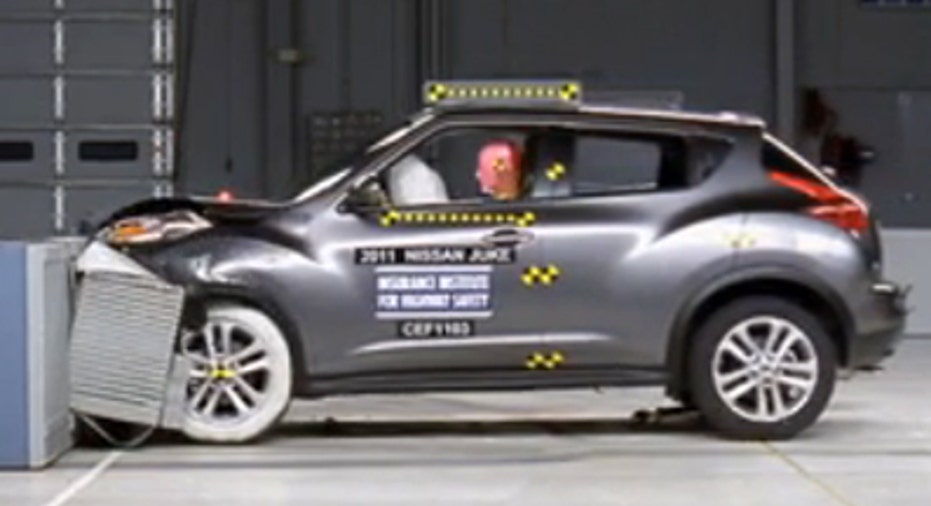Location-Based Crash Testing Should Mean Safer Cars

The Insurance Institute for Highway Safety (IIHS) just upgraded its Vehicle Research Center with a new positioning system that will allow more accurate vehicle crash testing, which could lead to safer cars.
Developed by Locata Corp., based in Canberra, Australia, LocataNet devices, which are about the size of a video cassette and use proprietary technology in league with GPS, will allow IIHS to more accurately read a vehicle's location during crash-avoidance tests, says Nunzio Gambale, Locata's CEO.
The new technology will help researchers better determine the effectiveness of these systems by judging braking distances and reaction times, among other elements, says Gambale.
The IIHS should now be able to improve its ratings of current crash safeguards already installed in some new model cars while gathering information for future improvements, he says.
"They can look at, say, a Mercedes crash-avoidance system and then compare it more correctly with one by Honda" and then inform consumers of the results, Gambale says. "This clearly could be very useful information when people decide which cars to buy based on safety. And could our technology be used in future systems that may be created? Absolutely. It's all a progression, an evolution."
Safety and Science: The Crash Avoidance Landscape
The IIHS has tested the safety features of vehicles for years, going back to 1969 when it encouraged automakers to make seat belts standard features. Its research continues to judge how well a car handles a front-end collision or what happens to passengers during a side impact.
Now, with so much crash-avoidance technology becoming standard on new cars, the IIHS has started to evaluate the systems that either help drivers react to highway dangers or react for them. The primary areas where LocataNet will come into play involve front and rear collisions and "lane departures," meaning when a vehicle drifts into a nearby lane.
The impact of these high-tech crash-avoidance systems is encouraging, both in preventing injuries and reducing insurance claims.
A recent IIHS report, "They're Working: Insurance Claims Data Shows Which New Technologies are Preventing Crashes," says studies by the Highway Loss Data Institute (HLDI) show that forward-collision avoidance technology using autonomous braking, especially when combined with adaptive headlights, reduce crashes more than any other system. The HLDI evaluated the self-braking systems offered by Acura, Mercedes-Benz and Volvo and found that property-damage liability claims fell by 14% compared to cars without.
Mazda, Acura, Volvo and Mercedes-Benz cars with adaptive headlights also brought drops in property-damage and bodily injury liability claims. With the exception of Acura, the number of bodily injury liability claims fell by 10% or more. Property-damage claims for all four manufacturers dropped from 5 to 10%.
The report also focused on how the various systems operate. Here's a brief rundown:
- Forward-collision avoidance systems: They let drivers know when traffic ahead is slowing down, usually through radar, sensors, cameras and light detection. A warning gives you time to react before the situation becomes dangerous.
- Forward-collision avoidance with autonomous braking: This works the same way, but the car slows down without the driver slamming the brakes. The IIHS notes that these systems might not prevent an accident, but they can reduce damage to a vehicle.
- Adaptive headlights: The system illuminates the road better by responding to the direction the driver is steering and the vehicle's speed.
- Blind-spot monitors: Drivers are alerted when sensors detect that another vehicle is approaching blind spots.
- Rear-backing: Cameras show drivers what they can't see behind their vehicles while backing up.
- Parking assist: Using sensors, a computer calculates the correct angles and steers the car into the parking space.
- Lane-departure warnings: Motorists are warned if they drift into the next lane without using a turn signal. The IIHS says these systems are still evolving because drivers have complained that they're annoying. Worse, they can be inaccurate.
Auto Insurance Discounts for Techno-Safety? Not so Fast
These newer safeguards may save your life, but there's no guarantee they'll come with a break on insurance premiums. As this point, most insurers aren't giving discounts for more advanced systems like crash-avoidance. (See: "My so-called safety feature discount.")
"Insurance companies are not offering discounts for most -- if not all -- of active safety devices," says Adam Kopstein, manager of safety and compliance for Volvo. "They have been resistant for a number of reasons, and we believe that discounts could really drive the demand and therefore increase the fitment rate."
Still, if a car is considered safe by insurers, it may cost you a bit less in insurance. While a certain feature may not come with an automatic discount, a car with modern crash-avoidance technology still might get a lower rate in underwriting in general. And more standard safety features, like anti-lock brakes, do qualify for a discount with most insurance companies. (See: "23 tips to save money on auto insurance.")
The original article can be found at Insurance.com:Location-based crash testing should mean safer cars